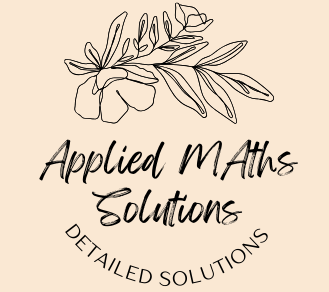Welcome to Applied Maths Chapter 15, where we embark on an exciting journey into the world of advanced mathematical concepts tailored for Class 11 students.” Unlock the power of applied mathematics with expert solutions crafted by professionals at AppliedMath.com. Designed to propel students towards academic success, our meticulously curated ML Aggarwal Solutions for Applied Mathematics cater to Class 11 and class 12 students seeking mastery in their examinations. Every query from the CBSE ML Aggarwal Books finds a comprehensive answer on our platform, complete with detailed explanations and step-by-step solutions presented in an easily understandable language.
Dive into the world of applied mathematics and discover how our resources can elevate your understanding and performance. Keep reading to explore the wealth of ML Aggarwal Solutions for Class 11 and Class 12 Applied Mathematics.
Here we provide you with Applied Maths Chapter 15, to help you gain a comprehensive understanding of the chapter and its concepts.

Applied Maths Chapter 15 Solutions
Taxation
Exercise – 15.2
Q.1 In the financial year 2019-20, Mr. Aman’s (age 35 years) gross income was Rs.6,98,000 (exclusive of HRA). He deposited Rs.6000 per month in NPS and Rs.24900 yearly as LIC premium. He purchased NSC worth Rs.40000. He donated Rs.15000 to the Chief Minister’s Relief Fund. Calculate the income tax paid by Mr. Aman at the end of the financial year.
Ans. Gross Income = Rs.698000
Standard deduction = Rs.50000
G.I – S.D = 698000 – 50000
= Rs.648000
Deduction Under 80C
NPS = 12 x 6000 = Rs.72000
LIC = Rs.24900
NSC = Rs.40000
Total = 72000 + 24900 + 40000
= Rs.136900
Balance = 648000 – 136900
= Rs.511100
80G (Donation) = Rs.15000
Taxable Income = 511100 – 15000
= Rs.496100
Income Tax = (496100 – 250000)5%
= 246100 x 5/100
= Rs.12305
Tax Rebate = Rs.12500
Income Tax = 12305 – 12500
= -195
Therefore, no tax will be paid (NIL)
Q.2 In the financial year 2019-20, Mrs. Sumita’s (age 62 years) annual income was Rs.7,58,000 (exclusive of HRA). She deposited Rs.7500 per month in GPF and Rs.23400 per half-year in LIC. She purchased an NSC worth Rs.25000 and donated Rs.20000 to a charitable trust on which a 50% deduction is allowed under section 80G. Calculate the income tax Mr. Sumita paid at the end of the financial year.
Ans. Gross Income = Rs.758000
Standard deduction = Rs.50000
G.I – S.D = 758000 – 50000
= Rs.708000
Deduction Under 80C
GPF = 12 x 7500 = Rs.90600
LIC = 23400 x 2 = R.46800
NSC = Rs.25000
Total = 90600 + 46800 + 25000
= Rs.162400
Max Deduction = Rs.150000
Balance = 708000 – 150000
= Rs.558000
Taxable Income = (558000 – 20000)50/100 = Rs.548000
Income Tax = 10000 + 48000 x 20/100 = 10000 + 9600
= Rs.19600
Health & Education CESS = 19600 x 4/100 = Rs.784
Total Income Tax = 19600 + 784
= Rs.20384
Q.3 In the financial year 2019-20, the annual income of Mr. Bhasin (age 48 years) was Rs.9,50,000 (exclusive of HRA). He deposited Rs.9200 per month in NPS and Rs.29000 as LIC premium. He paid Rs.42000 as tuition fees for his two children. He purchased a mediclaim policy of Rs.18400. He paid Rs.1,09,000 as interest and Rs.18,000 as principal on the home loan. Calculate the income tax paid by Mr. Bhasin at the end of the financial year.
Ans. Gross Income = Rs.950000
Standard deduction = Rs.50000
G.I – S.D = 950000 – 50000
= Rs.900000
Deduction Under 80C
NPS = 12 x 92000 = Rs.110400
LIC = Rs.29000
Tuition Fee = Rs.42000
Principal on home loan = Rs.18000
Total = 110400 + 29000 + 42000 + 18000 = Rs.199400
Maximum Rebate = Rs.150000
Balance = 900000 – 150000
= Rs.750000
Section 80D (Med. policy) = Rs.18400
Balance = 750000 – 18400
= Rs.731600
Section 24 (Interest on Home Loan) = Rs.109000
Taxable Income = 731600 – 109000
= Rs.622600
Income Tax = 12500 + 122600 x 20/100 = 12500 + 24520
= Rs.37020
Health & Education CESS = 37020 x 4/100 = Rs.1480.80
Net Income Tax = 30720 + 1480.80
= Rs.38501
Q.4 In the financial year 2019-20, the annual income of Mr. Rohit (age 30 years) was Rs.8,85,400 (exclusive of HRA). He deposited Rs.85000 in NPS, Rs.38000 in LIC, and invested Rs.30000 in NSC. He paid Rs.18000 as a tuition fee for her daughter’s education. If he paid Rs.1500 per month as advance income tax for 11 months, calculate the income tax paid by him at the end of the financial year.
Ans. Annual Income = Rs.885400
Deduction Under 80C
NPS = Rs.85000
LIC = Rs.38000
NSC = Rs.30000
Tuition Fee = Rs.18000
Total = 85000 + 38000 + 30000 + 18000 = Rs.171000
Maximum Rebate = Rs.150000
Balance = 171000 – 150000
= Rs.21000
Advance Tax Paid = 1500 x 11
= Rs.16500
Taxable Income = 731600 – 109000
= Rs.622600
Income Tax = 12500 + 122600 x 20/100 = 12500 + 24520
= Rs.37020
Q.5 In the financial year 2019-20, Mr. Reddy’s (age 58 years) annual salary was Rs.10,54,000 (exclusive of HRA). He earned Rs.17500 as interest on the savings bank account. Mr. Reddy deposited Rs.12000 per month in GPF and Rs.45000 towards the annual premium of his insurance policy. He paid Rs.198000 as interest and Rs.40000 as principal on the home loan. He also paid Rs.18000 interest on an education loan for his son. Mr. Reddy purchased a mediclaim policy of Rs.27829 for his family. Calculate the income tax paid by Mr. Reddy at the end of the financial year. Assuming the data given above for the financial year 2020-21, calculate the income tax with the new tax regime slab.
Ans.
Gross Income = 1054000 + 17500
= Rs.1071500
Standard deduction = Rs.50000
G.I – S.D = 950000 – 50000
= Rs.1021500
Deduction Under 80C
GPF = 12 x 12000 = Rs.144000
Insurance = Rs.45000
Principal on home loan = Rs.40000
Total = 114400 + 45000 + 40000
= Rs.229000
Maximum Deduction = Rs.150000
Balance = 1021500 – 150000
= Rs.
Section 80D (Med. policy) = Rs.18400
Balance = 750000 – 18400
= Rs.731600
Section 24 (Interest on Home Loan) = Rs.109000
Taxable Income = 731600 – 109000
= Rs.622600
Income Tax = 12500 + 122600 x 20/100 = 12500 + 24520
= Rs.37020
Health & Education CESS = 37020 x 4/100 = Rs.1480.80
Net Income Tax = 30720 + 1480.80
= Rs.38501
FAQ’s related to Applied Maths Chapter 15 on Taxation:
Q.1 What is the significance of studying taxation in Applied Maths chapter 15 for Class 11 students?
Ans. Studying taxation in applied mathematics provides students with practical knowledge about how mathematical concepts are used to analyze and understand real-world economic issues. It helps students develop critical thinking skills and an understanding of the role of mathematics in solving societal problems.
Q.2 What are the main topics covered in Applied Maths Chapter 15 on Taxation in the Class 11 textbook by M.L. Aggarwal?
Ans. The main topics covered in Chapter 15 on Taxation include tax incidence, types of taxes, tax revenue, tax evasion, tax avoidance, and tax administration. Students learn about the principles of taxation and how taxes affect individuals, businesses, and the economy.
These are few Frequently Asked Questions relating to Applied Maths Chapter 15
In Applied Maths chapter 15, you will explore fascinating topics that form the backbone of practical problem-solving techniques. Through clear explanations, illustrative examples, and step-by-step solutions, you’ll grasp complex concepts effortlessly. Whether you’re preparing for exams or simply eager to deepen your mathematical understanding, Applied Maths Chapter 15 promises an enriching learning experience that will set you on the path to success. Applied Maths Chapter 15, we delve deep into advanced mathematical concepts that are crucial for understanding.
Applied Maths Chapter 15 EXCERCISES:
FAQ’s related to Applied Maths Chapter 15 on Taxation:
Q.1 What is the significance of studying taxation in Applied Maths chapter 15 for Class 11 students?
Ans. Studying taxation in applied mathematics provides students with practical knowledge about how mathematical concepts are used to analyze and understand real-world economic issues. It helps students develop critical thinking skills and an understanding of the role of mathematics in solving societal problems.
Q.2 What are the main topics covered in Applied Maths Chapter 15 on Taxation in the Class 11 textbook by M.L. Aggarwal?
Ans. The main topics covered in Chapter 15 on Taxation include tax incidence, types of taxes, tax revenue, tax evasion, tax avoidance, and tax administration. Students learn about the principles of taxation and how taxes affect individuals, businesses, and the economy.
These are few Frequently Asked Questions relating to Applied Maths Chapter 15
In Applied Maths chapter 15, you will explore fascinating topics that form the backbone of practical problem-solving techniques. Through clear explanations, illustrative examples, and step-by-step solutions, you’ll grasp complex concepts effortlessly. Whether you’re preparing for exams or simply eager to deepen your mathematical understanding, Applied Maths Chapter 15 promises an enriching learning experience that will set you on the path to success. Applied Maths Chapter 15, we delve deep into advanced mathematical concepts that are crucial for understanding.
Applied Maths Chapter 15 EXCERCISES:
FAQ’s related to Applied Maths Chapter 15 on Taxation:
Q.1 What is the significance of studying taxation in Applied Maths chapter 15 for Class 11 students?
Ans. Studying taxation in applied mathematics provides students with practical knowledge about how mathematical concepts are used to analyze and understand real-world economic issues. It helps students develop critical thinking skills and an understanding of the role of mathematics in solving societal problems.
Q.2 What are the main topics covered in Applied Maths Chapter 15 on Taxation in the Class 11 textbook by M.L. Aggarwal?
Ans. The main topics covered in Chapter 15 on Taxation include tax incidence, types of taxes, tax revenue, tax evasion, tax avoidance, and tax administration. Students learn about the principles of taxation and how taxes affect individuals, businesses, and the economy.
These are few Frequently Asked Questions relating to Applied Maths Chapter 15
In Applied Maths chapter 15, you will explore fascinating topics that form the backbone of practical problem-solving techniques. Through clear explanations, illustrative examples, and step-by-step solutions, you’ll grasp complex concepts effortlessly. Whether you’re preparing for exams or simply eager to deepen your mathematical understanding, Applied Maths Chapter 15 promises an enriching learning experience that will set you on the path to success. Applied Maths Chapter 15, we delve deep into advanced mathematical concepts that are crucial for understanding.
Applied Maths Chapter 15 EXCERCISES:

